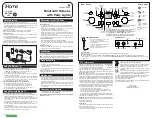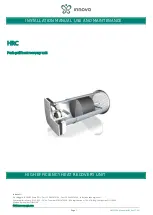
World Leaders in Ultra-Pure Heating
Revision 10
www.heateflex.com
01/17/13
405 E. Santa Clara St.
Arcadia, CA 91006-7218
Tel: (626) 599-8566 Fax: (626) 599-9567
6.0 Installation and Start-up Procedures
__________________________________________________________
6.1 Facilities Hook-Up
Connect the D.I. water inlet and outlet flanges to the D.I. water supply and delivery lines.
Supply lines should be PVDF or other high-temperature piping for a minimum of the last 36" if
horizontal and 72" if vertical from overhead to allow for thermal conduction and associated
heating up of the supply piping. For the delivery piping, make sure to account for thermal
expansion of the PVDF as it is considerable. To determine the amount of expansion to
anticipate, multiply the length of pipe in any one leg (measured in feet) by the difference in
temperature from ambient to the maximum process temperature to be used (measured in °F.)
and divide the product by the factor 1250. The result will be the growth, in inches, you can
expect in that leg when the system is heated up from ambient to operation temperature.
Expansion "loops" in the piping, or expansion joints, typically the Teflon bellows type, can be
used to accommodate the movement. Refer to piping manufacturer's data for details on laying
out expansion loops or contact Heateflex Corporation for assistance.
Steam, instrument air, condensate, pressure-relief venting and electrical power connection are
indicated on the unit as shipped and on the facilities drawing provided. The 12 to 15 psig
steam should be supplied from the user‟s regulated steam supply. A dedicated regulator for
each unit is recommended if other steam-powered equipment up stream of the unit may cause
variations in the steam pressure supplied to the unit as this will affect the process temperature
control. The vessel does not require a vacuum breaker unless so desired by the customer. The
user‟s steam trap and condensate pumping station are connected to either of the ball valves
provided at the bottom of the vessel with the other valve comprising a drain valve. Instrument
air usage is minimal - used only to actuate the steam auto-shutdown valve and the two isolation
valves when the unit is first turned on. An air pressure regulator is provided on the unit so any
supply pressure from 60 psig to 200 psig is suitable. The remote panel and main panel will be
connected via a user-supplied interface cable. The landing of the wires to the terminal strips in
the two panels can be done by user personnel or by Heateflex Corporation personnel at the
time of start-up. See the appendix for diagrams.
The outlets of the steam pressure relief valve and the D.I. pressure relief valves should be
piped to a suitable atmospheric drain, capable of handling hot water/steam at temperatures up
to 130°C.
To begin the start-up procedure, open the pneumatic isolation valves at the inlet and outlet of
the unit by pressing “FLOW” on the System Status screen (The “operational password” must
be entered). Next, check that the manual inlet/outlet valves and manual isolation valves on the
exchanger heads are all fully open if applicable. Let D.I. water flow through the unit until air
bubbles cease to appear in the downstream piping then close the manual inlet/outlet valves and
hydrostatically test the unit for leaks monitoring the pressure gauge on the left side of the unit.







































